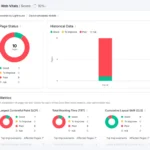
Internal linking is a fundamental SEO practice that is often overlooked. While external backlinks attract search engines to your site, internal links guide them through your content, helping both users and search engines understand the structure and hierarchy of your website. Done correctly, internal linking can improve rankings, enhance user experience, and distribute authority across your pages.
What is Internal Linking?
Internal linking refers to hyperlinks that connect one page of your website to another page within the same domain. These links can be embedded in content, menus, or footers, and they serve multiple purposes:
- Help users navigate your site.
- Distribute link equity (authority) from high-ranking pages to other pages.
- Signal the relationship between pages and the hierarchy of your website.
Why Internal Linking is Important for SEO
1. Enhances Website Crawling and Indexing
Search engines use bots to crawl websites. Internal links allow bots to discover new pages faster and understand how your content is connected, which improves indexing.
2. Improves Page Authority Distribution
Not all pages have equal authority. By linking high-authority pages to lower-authority pages, you can transfer link equity and help those pages rank better.
3. Boosts User Experience
Internal links guide users to related content, increasing time on site, reducing bounce rate, and encouraging users to explore more pages.
4. Helps Establish Content Hierarchy
Linking pages strategically shows search engines which pages are most important, helping prioritize ranking for your key topics.
5. Supports Keyword Strategy
Anchor text in internal links signals to search engines what the linked page is about, helping improve relevancy for targeted keywords.
Our Services SEO Services in Bhopal | SEO Services in Rajgir | SEO Services in Siwan | SEO Services in Azamgarh
Best Practices for Internal Linking
- Use Descriptive Anchor Text
Anchor text should clearly indicate the linked page’s content without being spammy. - Link Deeply
Avoid linking only to top-level pages. Link to deep pages that need more authority and exposure. - Maintain a Logical Structure
Follow a clear website hierarchy: Home → Category → Subcategory → Detailed Pages. - Limit Excessive Links
Too many links on a page can dilute authority and confuse users. Aim for relevant and purposeful links only. - Regularly Audit Your Links
Check for broken links or outdated pages and update links to ensure SEO efficiency.
Conclusion
Internal linking is a cornerstone of effective SEO. It enhances crawlability, distributes authority, improves user experience, and reinforces your content hierarchy. By implementing a thoughtful internal linking strategy, you can boost rankings, increase engagement, and support your overall SEO success.
A website that’s well-linked internally not only performs better in search engines but also provides a seamless experience for visitors, creating a win-win for both SEO and users.
FAQs About Internal Linking (Without Repeating Above Content)
1. How does internal linking affect new pages?
Internal linking helps new pages get discovered by search engines faster. Without links from existing pages, new content may take longer to appear in search results.
2. Can too many internal links harm SEO?
Yes. Overloading a page with too many links can dilute link equity and make navigation confusing, which may reduce both user engagement and SEO effectiveness.
3. Should every page have the same number of internal links?
No. Focus on linking strategically. Key pages should receive more links, while less critical pages need fewer internal connections.
4. Do internal links help with voice search?
Indirectly, yes. Properly linked content improves content discoverability and relevance, which makes it easier for voice assistants to surface accurate answers.
5. Can internal linking boost conversions?
Yes. Linking related content, product pages, or services guides users along the conversion funnel, increasing chances of completing desired actions.
6. How often should I review internal links?
Regularly—ideally quarterly—to ensure links are still relevant, working, and aligned with your SEO strategy.





